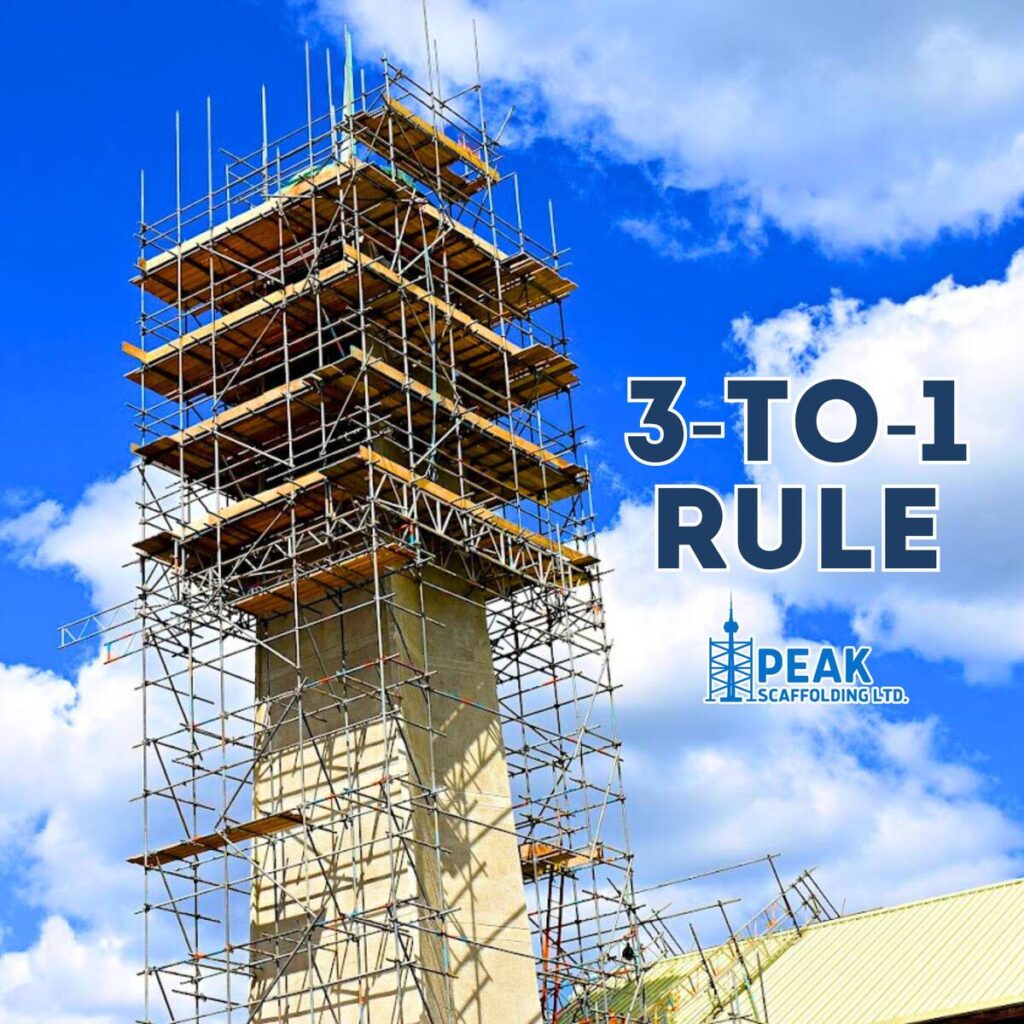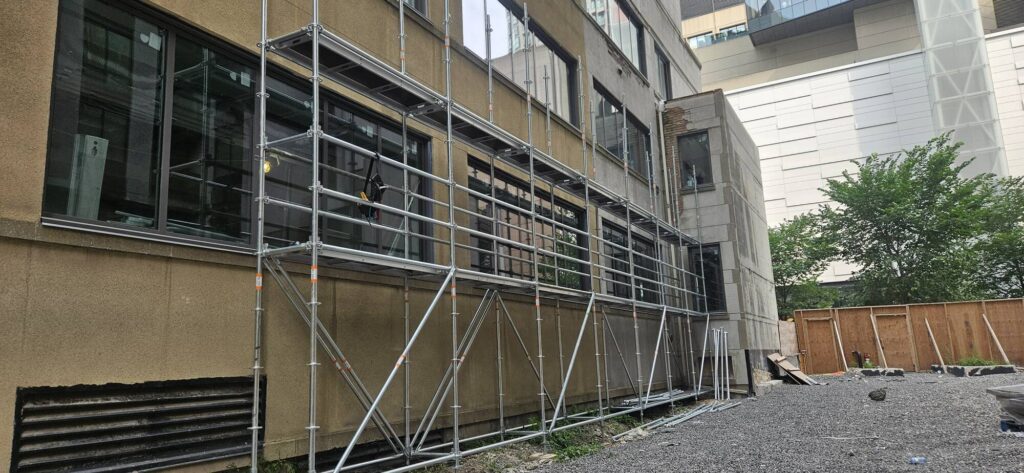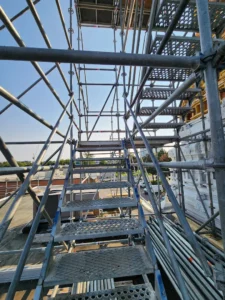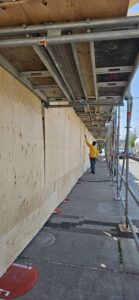Introduction

Scaffolding is a critical tool on construction sites, allowing workers to access hard-to-reach areas and complete tasks at height. However, these temporary structures also pose inherent risks, particularly when it comes to stability. That’s where the 3-to-1 rule in scaffolding comes into play, acting as a fundamental guideline to prevent accidents and ensure worker safety.
Understanding the 3-to-1 Rule
In its simplest form, the 3-to-1 rule states that for every 3 feet (or 1 meter) of vertical height, a freestanding scaffold should have at least 1 foot (or 0.3 meters) of base width in its narrowest dimension.
Think of it like a pyramid – the wider the base, the more stable the structure.
- Height: The total height of the scaffold, from the ground to the top working platform.
- Base Width: The shortest distance across the base of the scaffold.
This ratio ensures that the center of gravity remains within the base of the scaffold, preventing it from tipping over.
Why is the 3-to-1 Rule Important?
Scaffolding collapses can have devastating consequences, leading to serious injuries or even fatalities. The 3-to-1 rule is a simple yet crucial safety measure that helps to prevent these accidents by ensuring the scaffold’s stability.
By adhering to this rule, you significantly reduce the risk of:
- Tipping: The scaffold becoming unbalanced and toppling over.
- Collapse: The structure failing under its own weight or due to external forces.
- Worker Falls: Workers losing their balance or footing due to an unstable platform.
In essence, the 3-to-1 rule provides a safety margin, allowing the scaffold to withstand minor shifts in weight or external forces without compromising its stability.
When Does the 3-to-1 Rule Apply?
While the 3-to-1 rule is a cornerstone of scaffolding safety, it’s crucial to understand when it specifically comes into play.
- Freestanding Scaffolds: This rule is most critical for freestanding scaffolds — those not attached or tied to any other structure. These scaffolds rely entirely on their base for stability, making the 3-to-1 ratio vital for preventing tipping.
- Sections of Complex Setups: Even within larger, more intricate scaffolding systems (like those often seen on high-rises), there may be sections that are essentially freestanding. For these portions, adhering to the 3-to-1 rule is equally important.
- Regulatory Variations: It’s also crucial to recognize that specific scaffolding regulations can vary. Always consult local building codes and safety guidelines for your area. In Toronto and Ontario, the 3-to-1 rule is generally accepted as a best practice, and often explicitly required in certain situations.
Understanding the scope of the 3-to-1 rule helps ensure that you apply it correctly and take necessary precautions to maintain stability in your scaffolding structures.
Exceeding the 3-to-1 Ratio: When and How
While the 3-to-1 rule is a golden standard for scaffolding stability, there are instances where project requirements might necessitate exceeding this ratio. However, it’s important to proceed with caution and take additional measures to ensure safety.
When Exceeding Might Be Necessary
- Limited Space: In tight urban environments like Toronto, where space is often constrained, achieving the ideal 3-to-1 ratio may not be feasible.
- Height Requirements: Some projects require working at significant heights, potentially pushing the scaffold beyond the recommended ratio.
- Specific Design Needs: Certain architectural features or construction tasks might demand a taller, narrower scaffold structure.
Safety Measures for Exceeding the Ratio
If exceeding the 3-to-1 ratio is unavoidable, consider implementing these additional safety measures:
- Widen the Base: Increase the scaffold’s stability by expanding its base. This can be achieved through:
- Outriggers: Extendable supports that widen the scaffold’s footprint.
- Additional Supports: Adding extra legs or bracing to the base structure.
- Tie-Offs: Securely tie the scaffold to the building or other stable structures. This requires careful engineering and should only be done by qualified professionals.
- Engineering Consultation: Consult a professional engineer to assess the stability of the scaffold and recommend additional safety measures if needed.
Remember, exceeding the 3-to-1 ratio should only be done when absolutely necessary and with careful consideration for safety. It’s always best to consult with a scaffolding expert to ensure the stability of your structure and protect the well-being of your workers.
PEAK Scaffolding: Your Partner in Safety
At PEAK Scaffolding, we understand the challenges of working in confined spaces or at great heights. Our team of experienced professionals can help you navigate these situations safely and effectively. We offer expert design and engineering services to ensure that your scaffolding, even when exceeding the 3-to-1 ratio, remains stable and compliant with all regulations.
We’re committed to providing you with the right scaffolding solution for your unique project needs, prioritizing safety and efficiency at every step.
Beyond the 3-to-1 Rule: Other Stability Factors

While the 3-to-1 rule is a crucial guideline for scaffolding stability, it’s not the only factor to consider. Several other elements can influence the safety and integrity of your scaffolding system.
Ground Conditions: The Foundation of Stability
The ground on which your scaffold rests is literally its foundation. It’s essential to ensure that the ground is:
- Level: Uneven ground can create instability, causing the scaffold to lean or shift. Use leveling plates or adjust the scaffold’s legs to compensate for any unevenness.
- Firm: Soft or unstable ground can lead to the scaffold sinking or shifting. If necessary, use base plates or other supports to distribute the weight and ensure a solid foundation.
Weather Conditions: Prepare for the Elements
Toronto’s weather can be unpredictable, and extreme conditions can impact scaffolding stability. Take these precautions:
- Wind: High winds can exert significant force on a scaffold, increasing the risk of collapse. If wind speeds exceed manufacturer recommendations, consider dismantling the scaffold or taking additional measures to secure it, such as adding tie-offs or wind bracing.
- Rain and Snow: Clear platforms of any accumulation to prevent slips and falls. Wet or icy surfaces can be extremely hazardous for workers.
- Ice: Avoid using scaffolding during icy conditions, as ice buildup can make surfaces slippery and compromise stability.
Regular Inspections: An Ounce of Prevention
Regular inspections are essential for identifying and addressing potential stability issues before they become major problems. A competent person should inspect the scaffolding:
- Before each use: Check for any damage, loose components, or signs of instability.
- After any alterations or adverse weather events: Ensure the scaffolding remains safe and secure after modifications or exposure to harsh conditions.
- At regular intervals: Frequency depends on the type of scaffold and its use, but weekly or monthly inspections are typical.
The Human Factor: Training and Vigilance
Even the most well-designed scaffolding system can be compromised by human error. Ensure that all workers involved in scaffolding operations are adequately trained and understand the importance of following safety procedures. Overconfidence and complacency can lead to accidents, so encourage a culture of vigilance and continuous safety awareness on your construction site.
By considering these additional stability factors and prioritizing ongoing safety practices, you can significantly enhance the safety and effectiveness of your scaffolding system, even beyond the 3-to-1 rule. Remember, a safe work environment is essential for project success and worker well-being.
PEAK Scaffolding's Expertise: Your Partner in Safe Scaffolding Practices
At PEAK Scaffolding, we’re not just scaffolding providers; we’re your partners in safety. We understand the critical importance of scaffold stability and go above and beyond to ensure the well-being of your workers and the success of your project.
Our Dedication to Safety
Safety is at the core of our company culture. We prioritize it in every aspect of our operations, from the initial design and engineering of your scaffolding system to its installation, maintenance, and dismantling.
- Experienced Professionals: Our team comprises seasoned scaffolding experts with extensive knowledge and training in industry best practices.
- Rigorous Training: We invest in ongoing training and certification for our team, ensuring they stay up-to-date on the latest safety regulations and techniques.
- Meticulous Inspections: We conduct thorough inspections of all our scaffolding equipment and installations to identify and address any potential hazards.
- Proactive Approach: We believe in preventing accidents before they happen. Our team is trained to identify and mitigate risks, promoting a proactive safety culture on your construction site.
Compliance and Industry Standards
We’re committed to adhering to the highest industry standards and ensuring that your scaffolding system complies with all relevant regulations. We’re certified by leading organizations like the Access Association of Canada (AAC) and the Canadian Standards Association (CSA), demonstrating our dedication to quality and safety.
Expertise Beyond the 3-to-1 Rule
While we recognize the importance of the 3-to-1 rule, we also understand that every project is unique. Our expertise extends beyond basic guidelines, and we’re equipped to handle complex scaffolding designs and challenging site conditions.
Whether you need a custom-engineered solution for a unique structure or guidance on overcoming the 3-to-1 ratio safely, we have the knowledge and experience to ensure your scaffolding system is both stable and compliant.
Partnering with PEAK Scaffolding
Choosing PEAK Scaffolding means choosing a partner who prioritizes safety and understands the intricacies of scaffolding stability. We work closely with you to assess your project needs, design a tailored solution, and ensure its safe implementation and maintenance throughout your project.
FAQs on the 3-to-1 Rule
Let’s address some common questions about the 3-to-1 rule to provide further clarity and ensure you have a comprehensive understanding of this critical safety principle.
Primarily, the 3-to-1 rule applies to freestanding scaffolds that are not tied or braced to a building or other stable structure. These scaffolds rely solely on their base for stability, making the ratio crucial for preventing tipping.
However, even within larger, more complex scaffolding systems, there may be sections or components that are essentially freestanding. In those instances, the 3-to-1 rule would still be relevant for ensuring the stability of those particular sections.
There might be situations where project needs necessitate a taller scaffold than what the 3-to-1 ratio would typically permit. In such cases, it’s crucial to consult with a qualified engineer or scaffolding expert to explore alternative solutions and ensure the structure’s stability.
Some options might include:
- Widening the base: Expanding the scaffold’s footprint with outriggers or additional supports can increase its stability and allow for a taller structure.
- Tying the scaffold to the building: Securing the scaffold to the building with tie-ins can provide additional support and stability, allowing for greater height. However, this requires careful engineering and should only be done by professionals.
- Using a different type of scaffolding: In some cases, a different scaffolding system, such as a suspended scaffold or a mast climber, may be more suitable for reaching greater heights while maintaining stability.
Adhering to the 3-to-1 rule is a good starting point, but other factors contribute to scaffolding stability:
- Ground Conditions: Ensure the ground is level and firm. Use base plates or other supports if necessary to create a stable foundation.
- Load Distribution: Distribute the weight of workers, materials, and equipment evenly across the scaffold platform to avoid imbalance.
- Weather Conditions: Be mindful of wind, rain, and snow, which can impact stability. Take precautions or avoid using the scaffold in adverse weather.
- Regular Inspections: Conduct frequent inspections to identify and address any potential hazards or signs of instability.
Ignoring the 3-to-1 rule can have severe consequences, including:
- Scaffold Collapse: An unstable scaffold can collapse, leading to serious injuries or fatalities for workers and anyone below.
- Fines and Legal Action: Non-compliance with safety regulations can result in hefty fines and potential legal action against the responsible parties.
- Project Delays: Accidents and injuries can cause significant delays and disruptions to your project timeline.
At PEAK Scaffolding, we prioritize safety and compliance in all our scaffolding solutions. Our team of experts can:
- Assess your project needs: We’ll evaluate your site and requirements to determine the most appropriate scaffolding system and ensure it adheres to the 3-to-1 rule or other necessary safety measures.
- Design a stable structure: Our engineers can design custom scaffolding solutions that meet your specific needs while prioritizing stability and safety.
- Provide expert installation: Our trained professionals will erect your scaffolding with precision and care, ensuring it’s secure and compliant.
- Conduct regular inspections: We offer ongoing maintenance and inspection services to identify and address any potential stability issues.
By partnering with PEAK Scaffolding, you can have peace of mind knowing that your scaffolding system is built on a solid foundation of safety and expertise.
Conclusion: Mastering Scaffolding Stability
The 3-to-1 rule in scaffolding isn’t just a number; it’s a fundamental principle that safeguards lives and projects. By understanding this rule and the factors that influence stability, you’re taking a proactive step towards preventing accidents and ensuring a safe work environment.
Remember, prioritizing stability goes beyond simply adhering to the 3-to-1 ratio. Careful consideration of ground conditions, load distribution, weather, and regular inspections are all crucial components of a safe scaffolding system.
At PEAK Scaffolding, we’re passionate about safety and committed to providing scaffolding solutions that meet the highest standards. Whether you need a standard setup or a complex custom design, we have the expertise to ensure your scaffolding is stable, compliant, and built to last.
Don’t compromise on safety. Contact PEAK Scaffolding today for expert guidance and reliable scaffolding solutions that empower your team to work with confidence at any height.
Related Posts


Toronto Building Codes and Scaffolding: What You Must Comply With




